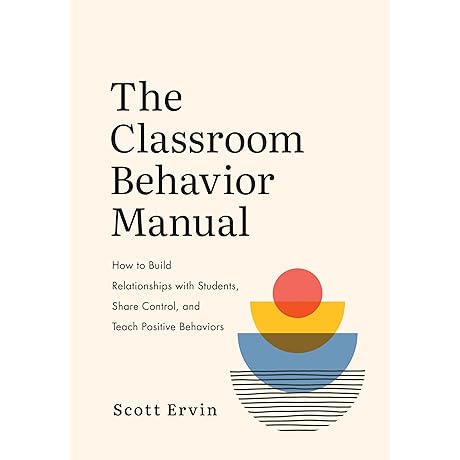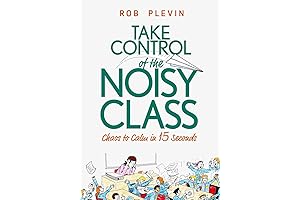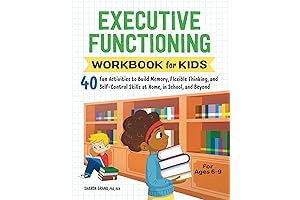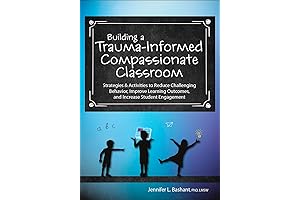· classroom behavior management · 13 min read
The Classroom Behavior Manual: Key to a Harmonious and Effective Learning Environment
Delve into 'The Classroom Behavior Manual,' your comprehensive guide to fostering positive student relationships, empowering them to take ownership, and instilling a culture of respectful behavior that supports optimal learning.
Introducing 'The Classroom Behavior Manual,' an invaluable resource for educators seeking to transform their classrooms into havens of positive behavior, strong relationships, and academic success. This guidebook empowers you with practical strategies to build rapport with students, establish clear expectations, and foster self-discipline, creating an environment where every learner thrives.
Overview

PROS
- Empowers educators to build strong student relationships fostering a positive learning environment.
- Provides practical strategies for sharing control, allowing students to take ownership of their behavior.
CONS
- May require significant time and effort to implement fully.
- Some strategies may not be suitable for all classrooms or teaching styles.
The Classroom Behavior Manual is an invaluable resource for educators seeking to transform their classroom into a positive and productive learning space. With its focus on building relationships, sharing control, and teaching positive behaviors, this manual equips teachers with the tools they need to foster a classroom culture where students feel respected, engaged, and empowered.
The authors, Tonya Fredrich and Chris Ervin, draw on their extensive experience as educators and behavior specialists to provide a comprehensive guide that addresses the challenges of classroom management. They emphasize the importance of creating a positive and supportive learning environment where students feel valued and connected to their teachers. The strategies outlined in the manual empower teachers to build strong relationships with students, based on trust and mutual respect. This approach fosters a sense of belonging and motivation, which is essential for effective learning.

PROS
- Provides a comprehensive framework for implementing restorative practices in the classroom.
- Offers practical strategies and techniques for managing student behavior effectively.
CONS
- May require significant time and effort to implement fully.
- May not be suitable for all classroom settings or student populations.
The Classroom Behavior Manual is an essential resource for any educator looking to create a more positive and productive classroom environment. It provides a comprehensive introduction to restorative practices, a research-based approach to discipline that focuses on repairing relationships and building community. The manual includes step-by-step instructions for implementing restorative practices in the classroom, as well as practical strategies and techniques for managing student behavior effectively. It also provides a wealth of resources and support for educators, including online training modules, printable materials, and access to a community of educators who are using restorative practices in their classrooms.
Whether you are a new teacher just starting out or an experienced educator looking for new ways to manage student behavior, The Classroom Behavior Manual is a valuable resource that will help you create a more positive and productive learning environment.

PROS
- Empowers teachers with practical, effective strategies to manage challenging classroom behaviors.
- Provides a wealth of techniques for creating a positive and productive learning environment.
CONS
- Some strategies may require significant time and effort to implement.
- Certain techniques may not be suitable for all classroom situations or age groups.
Take Control of the Noisy Class is an indispensable guide for teachers seeking to establish and maintain a well-behaved classroom. Backed by years of experience, the authors provide a comprehensive toolkit of practical strategies that can transform even the most chaotic classrooms into oases of calm and productivity.
The manual's strength lies in its emphasis on proactive approaches. By equipping teachers with techniques such as effective communication, clear expectations, and consistent positive reinforcement, the authors empower teachers to create a classroom culture where students feel respected, valued, and motivated to behave appropriately. Additionally, the book offers valuable insights into common behavioral challenges and provides specific solutions tailored to each situation.

PROS
- Provides a comprehensive overview of restorative practices in the classroom.
- Offers practical strategies and tools for implementing restorative circles and conferences.
- Facilitates the development of a positive and respectful classroom environment.
- Empowers students to take ownership of their behaviors and contribute to a harmonious classroom culture.
CONS
- May require additional resources and training to fully implement restorative practices.
- May not be suitable for all classroom settings or students with severe behavioral challenges.
This quick reference guide is an invaluable resource for educators seeking to implement restorative practices in their classrooms. It provides a clear and concise overview of the key principles and strategies of restorative justice, empowering teachers to create a positive and supportive learning environment for all students.
The guide offers practical tips and tools for facilitating restorative circles and conferences, enabling teachers to address student behavior in a collaborative and respectful manner. By fostering open dialogue, accountability, and empathy, restorative practices help students develop self-awareness, take ownership of their actions, and contribute to a harmonious classroom culture. While additional resources and training may be necessary for full implementation, this guide provides a solid foundation for educators to begin incorporating restorative practices into their classrooms.

PROS
- Empowers educators with proven RTI strategies to effectively address challenging behaviors in the classroom.
- Provides a practical guide for implementing collaborative PLC processes that foster a positive and supportive learning environment.
CONS
- May require additional resources and professional development for full implementation.
- Some strategies may not be suitable for all students or classroom settings.
Behavior Solutions: The Classroom Behavior Manual is an invaluable resource for educators seeking to create a positive and productive learning environment for all students. This comprehensive guide provides a wealth of research-based RTI strategies that effectively address challenging behaviors and promote social-emotional development. The manual's emphasis on collaboration among teachers, administrators, and parents is a key strength, fostering a cohesive and supportive approach to behavior management.
The manual's practical and user-friendly format makes it easy for educators to implement the strategies and monitor progress. Case studies and real-life examples illustrate the effectiveness of the RTI process, providing valuable insights for educators. Behavior Solutions not only equips teachers with essential tools for managing challenging behaviors but also empowers them to create a classroom culture that values respect, responsibility, and academic achievement.

PROS
- Provides clear and concise behavior interventions that can be implemented in 15 minutes or less.
- Offers practical advice and support for educators, counselors, and parents.
CONS
- May not be suitable for all student populations.
- Some strategies may require additional resources or training to implement.
The Classroom Behavior Manual: 15-Minute Focus is an invaluable resource for educators, counselors, and parents who are seeking effective behavior management strategies. This manual provides a comprehensive collection of evidence-based interventions that can be implemented in the classroom or at home in just 15 minutes or less. Each intervention is clearly explained and supported by research, making it easy to understand and implement.
One of the strengths of this manual is its focus on practical solutions. The interventions are designed to be easy to implement and require minimal resources. Additionally, the authors provide helpful tips and suggestions for adapting the interventions to meet the needs of individual students. Overall, The Classroom Behavior Manual: 15-Minute Focus is a valuable tool for anyone who is looking to improve student behavior and create a more positive learning environment.

PROS
- Packed with 40 interactive activities to foster memory, cognitive flexibility, and self-control.
- Tailored for home and school settings, empowering parents and educators to support children's development.
CONS
- Certain activities may require adult supervision and guidance for younger children.
- Progress tracking tools could be further enhanced to monitor individual growth more effectively.
Nurture Executive Functioning Skills with Joyful Activities
Immerse your child in a world of fun and learning with the 'Executive Functioning Fun Book for Kids.' This interactive workbook is a treasure trove of engaging activities designed to strengthen essential EF skills like memory, flexible thinking, and self-control. Each activity is meticulously crafted to captivate young minds while promoting cognitive growth. Whether at home or in the classroom, this workbook empowers parents and educators to foster a child's EF development in a joyful and playful manner.

PROS
- Offers practical strategies and activities for creating a trauma-informed, compassionate classroom.
- Provides guidance on how to address challenging behaviors, improve learning outcomes, and increase student engagement.
- Includes real-life examples and case studies to illustrate the effectiveness of the strategies presented.
- Empowers educators to create a supportive and inclusive learning environment for all students.
- Helps students develop self-regulation skills and emotional intelligence.
CONS
- Some readers may find the book to be too focused on theory and not enough on practical application.
- The book may not be suitable for all teachers, as it requires a commitment to trauma-informed practices.
- The book's length may be daunting for some readers.
Building a Trauma-Informed, Compassionate Classroom is an essential guide for educators who want to create a supportive and positive learning environment for all students. The book provides practical strategies and activities that can be used to address challenging behaviors, improve learning outcomes, and increase student engagement. Written by experts in the field of trauma-informed education, the book offers a comprehensive overview of trauma, its impact on learning, and how to create a classroom that is trauma-sensitive.
The book is divided into three sections. The first section provides an overview of trauma and its impact on learning. The second section offers practical strategies for creating a trauma-informed classroom. The third section provides activities that can be used to teach students self-regulation skills and emotional intelligence. Each section is packed with real-life examples and case studies that illustrate the effectiveness of the strategies presented. Building a Trauma-Informed, Compassionate Classroom is an invaluable resource for any educator who wants to create a supportive and inclusive learning environment for all students.

PROS
- Empowers educators with practical and effective behavior management techniques
- Fosters a positive and respectful learning environment, reducing disruptions
- Provides guidance on building strong student-teacher relationships, promoting intrinsic motivation
CONS
- May require a shift in mindset and teaching practices
- Implementation may vary in effectiveness depending on individual classroom dynamics
For educators seeking to establish a harmonious and respectful classroom environment, 'The Classroom Behavior Manual' emerges as a valuable resource. This comprehensive guide offers a detailed approach to discipline, emphasizing the significance of building strong relationships and fostering student accountability.
The author's insights are grounded in the philosophy of 'Discipline with Dignity,' a paradigm shift from traditional punishment-based methods towards a more positive and empowering approach. The manual provides practical strategies for addressing common behavioral challenges, promoting self-regulation and intrinsic motivation among students. Educators will find themselves equipped with a wealth of tools and techniques to create a classroom where students feel valued, respected, and empowered to learn.

PROS
- Concise and practical guidance for teachers to establish and maintain effective classroom behavior.
- Proven techniques for managing common classroom challenges, creating a productive learning atmosphere.
CONS
- May require customization to adapt to specific school or grade level contexts.
- Some topics, such as dealing with severe behavior issues, could be explored in greater depth.
Teaching Behavior: Managing Classrooms Through Effective Instruction is an indispensable guide for educators seeking to establish a positive classroom culture and promote student success. It offers evidence-based strategies and practical tips to create a well-managed learning environment where students can thrive. The manual is lauded for its clear and concise approach, making it accessible for teachers of all experience levels.
This comprehensive manual empowers teachers with effective techniques for addressing common classroom behaviors, such as talking out of turn, lack of engagement, and disruptive behavior. By implementing these strategies, teachers can foster a positive and productive learning environment, creating a foundation for academic success. The manual also emphasizes the importance of positive reinforcement and building strong relationships with students, recognizing their individual needs and strengths.
In 'The Classroom Behavior Manual,' you'll discover a wealth of research-based techniques for managing student conduct effectively. Learn how to create a positive classroom culture, prevent discipline problems, and respond to challenging behaviors in a restorative and supportive manner. With its emphasis on building strong relationships and empowering students, this manual provides a holistic approach to classroom management, fostering a harmonious and productive learning environment where all students feel respected, valued, and motivated to succeed.
Frequently Asked Questions
What key principles underpin the Classroom Behavior Manual?
The Classroom Behavior Manual emphasizes building positive relationships with students, sharing control through clear expectations and consequences, and teaching positive behaviors through proactive and restorative practices.
How can the manual help educators improve student behavior?
The manual provides educators with practical strategies for preventing discipline problems, responding to challenging behaviors effectively, and creating a positive classroom environment that fosters self-discipline and respect.
What are the benefits of using a restorative approach to classroom management?
Restorative practices focus on repairing harm, building relationships, and empowering students to take ownership of their behavior, leading to improved student-teacher relationships, reduced conflict, and a more positive and supportive classroom culture.
How does the manual support educators in managing students with challenging behaviors?
The manual offers guidance on understanding the root causes of challenging behaviors, developing individualized behavior plans, and implementing effective interventions that promote positive behavior change.
Can the manual be used by educators at all levels?
Yes, the manual provides strategies and techniques that are applicable to educators at all levels, from elementary to high school and beyond.













